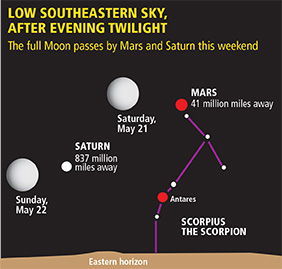Since March I’ve been getting frequent inquiries about a bright red “star” in the low southwest sky just before morning twilight. Lately I’ve also heard about a really bright red “star” rising in the southeast shortly after sunset. In both cases it’s no star, but Mars, one of our next-door neighbors in our solar system.
Every 25 months, Mars and Earth make a close pass to each other as they both orbit the sun. This is called an opposition. It takes more than two years for this to happen. A benefit of opposition is that Mars is available for us to see all night, rising at sunset and setting at sunrise.
Some oppositions are closer than others, however. That’s because the orbits of Mars and Earth are not exactly circular, but more elliptical or oval-shaped.
Back in 2003 Earth and Mars were separated by only 34.6 million miles. It was the closest Earth and Mars had been to each other in 60,000 years. This weekend Mars is a little farther away at over 41 million miles, but it is the closest it’s been since 2005. During the next opposition, in late July of 2018, Mars will be nearly as close as it was in 2003 at 35.8 million miles away.
Since Mars is “flying low” as it moves from the southeast to southwest every night, we’re forced to observe it through more of Earth’s blurring atmosphere that’s thicker from our viewpoint near the horizon than it is overhead. Mars will appear extra fuzzy when it first rises, but the view will be a little less murky until about 10:30 to 11 p.m.
You’ll need patience and persistence observing Mars through any telescope. Viewing conditions can vary from night to night. Not only do you need clear skies but you also need a fairly still, non-turbulent atmosphere between you and Mars. Strong winds aloft can certainly murk up the seeing conditions. If you don’t see much detail on Mars on one night don’t give up. Try other nights. You also need to look at Mars through the eyepiece in your scope for extended periods of time. Look through your scope for at least five to ten minutes at a time to let your eye get used to the light levels. Of course, you’ll have to push your telescope along every few minutes to keep Mars in view, unless you’re lucky enough to have a drive system on your scope to keep up with Earth’s rotation.
Enjoy the current Martian invasion.
Mike Lynch is an amateur astronomer and professional broadcast meteorologist for WCCO Radio in Minneapolis and is author of the book, “Stars, a Month by Month Tour of the Constellations” published by Adventure Publications available at bookstores at http://www.adventurepublications.net
Talk to us
> Give us your news tips.
> Send us a letter to the editor.
> More Herald contact information.

























